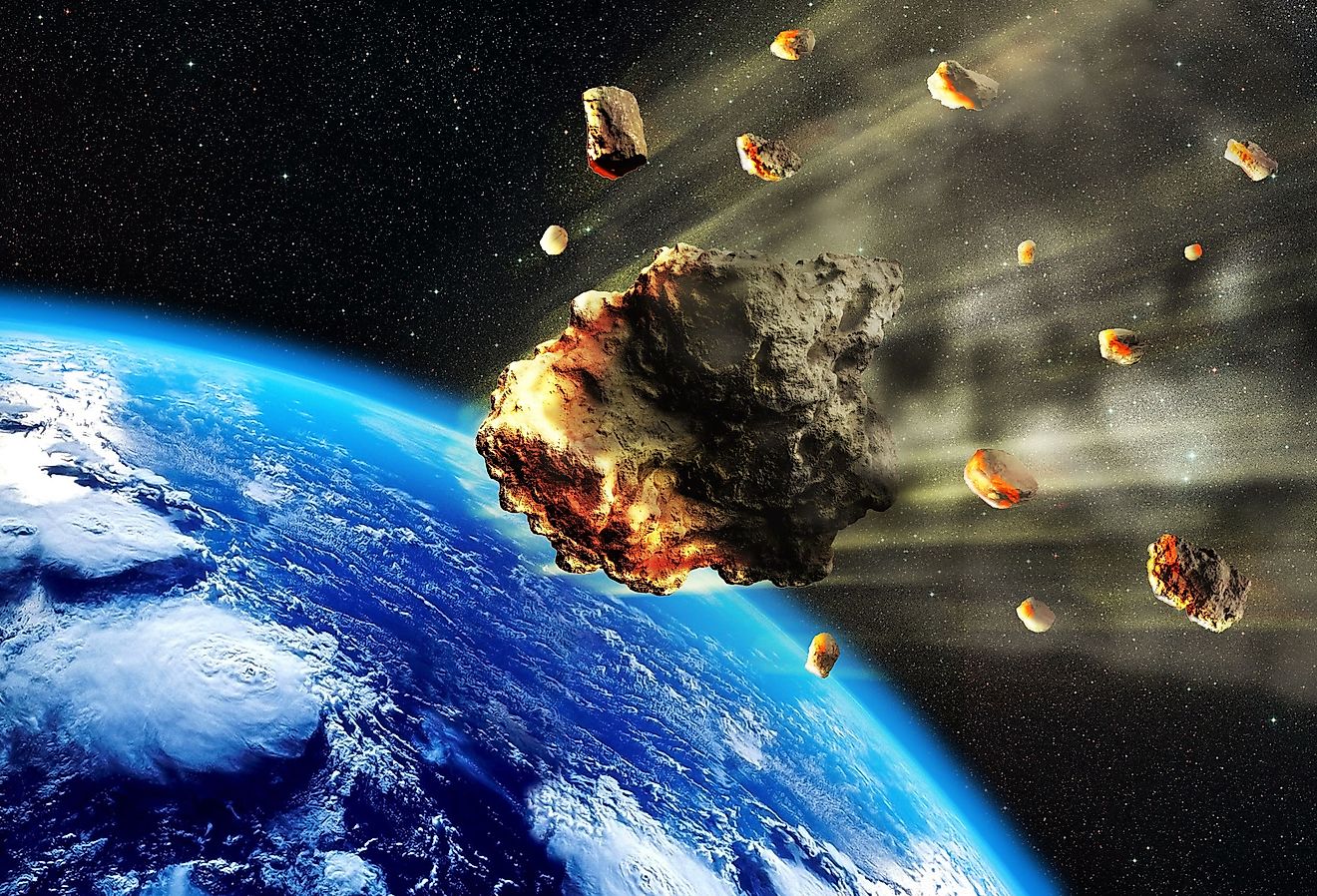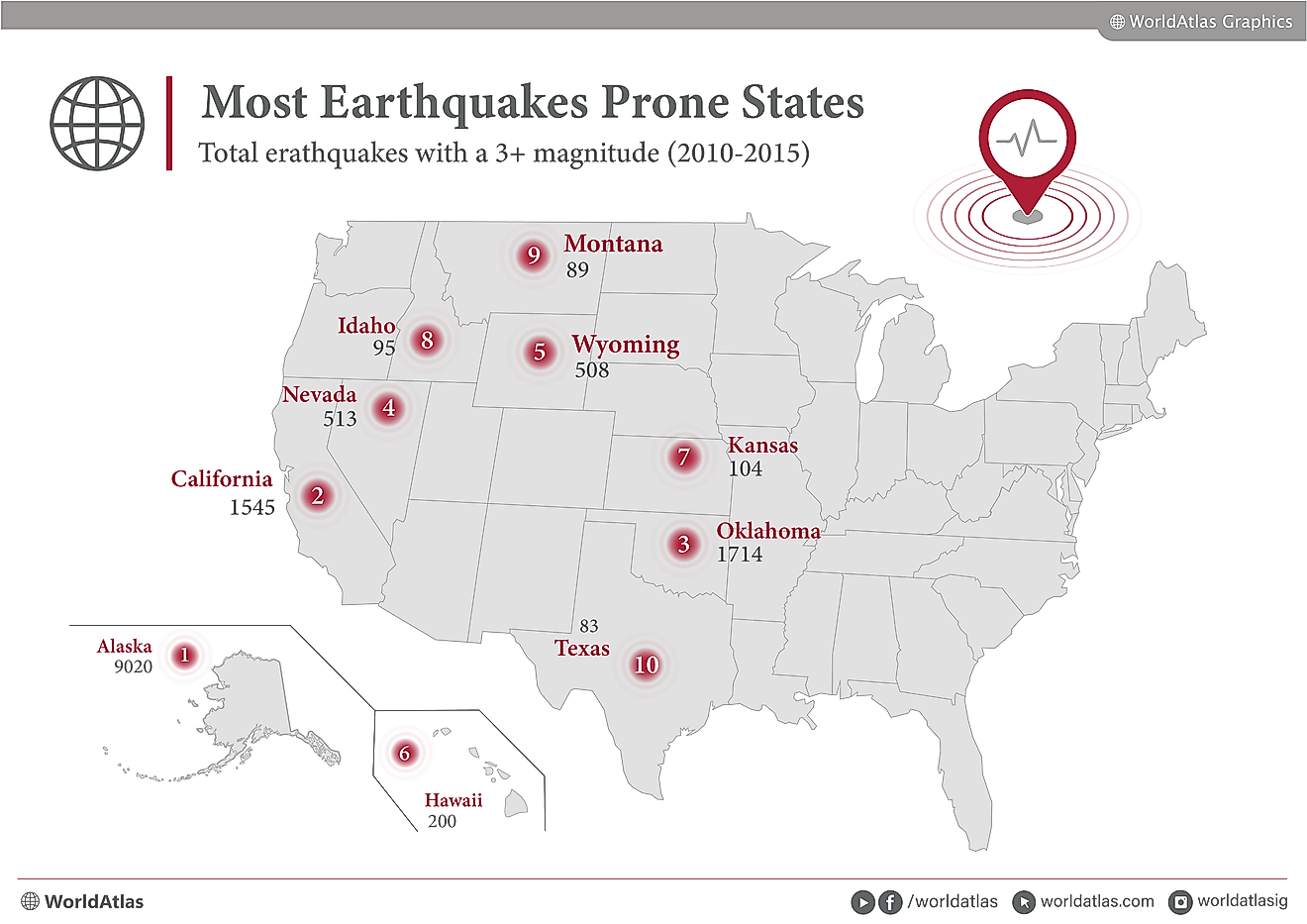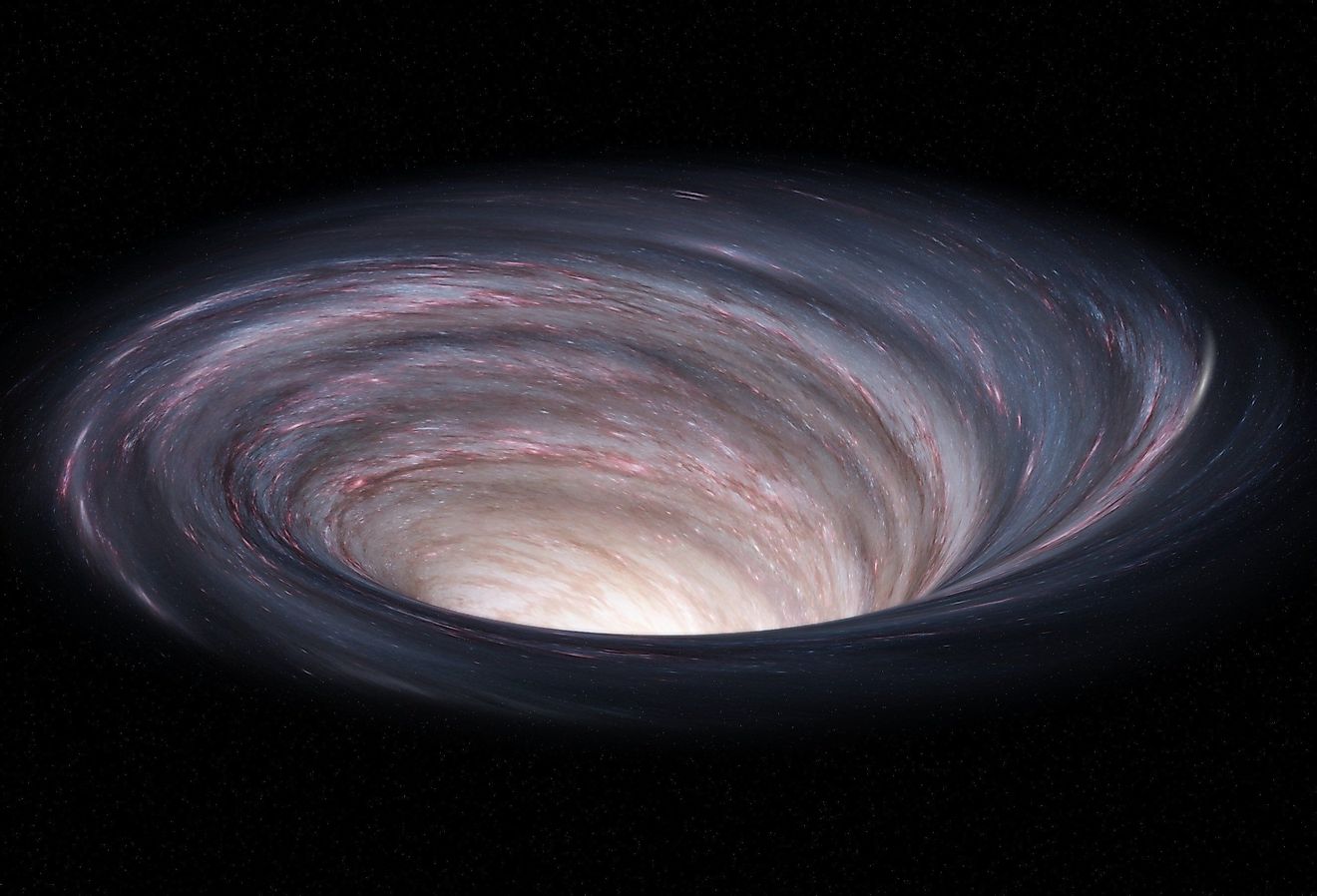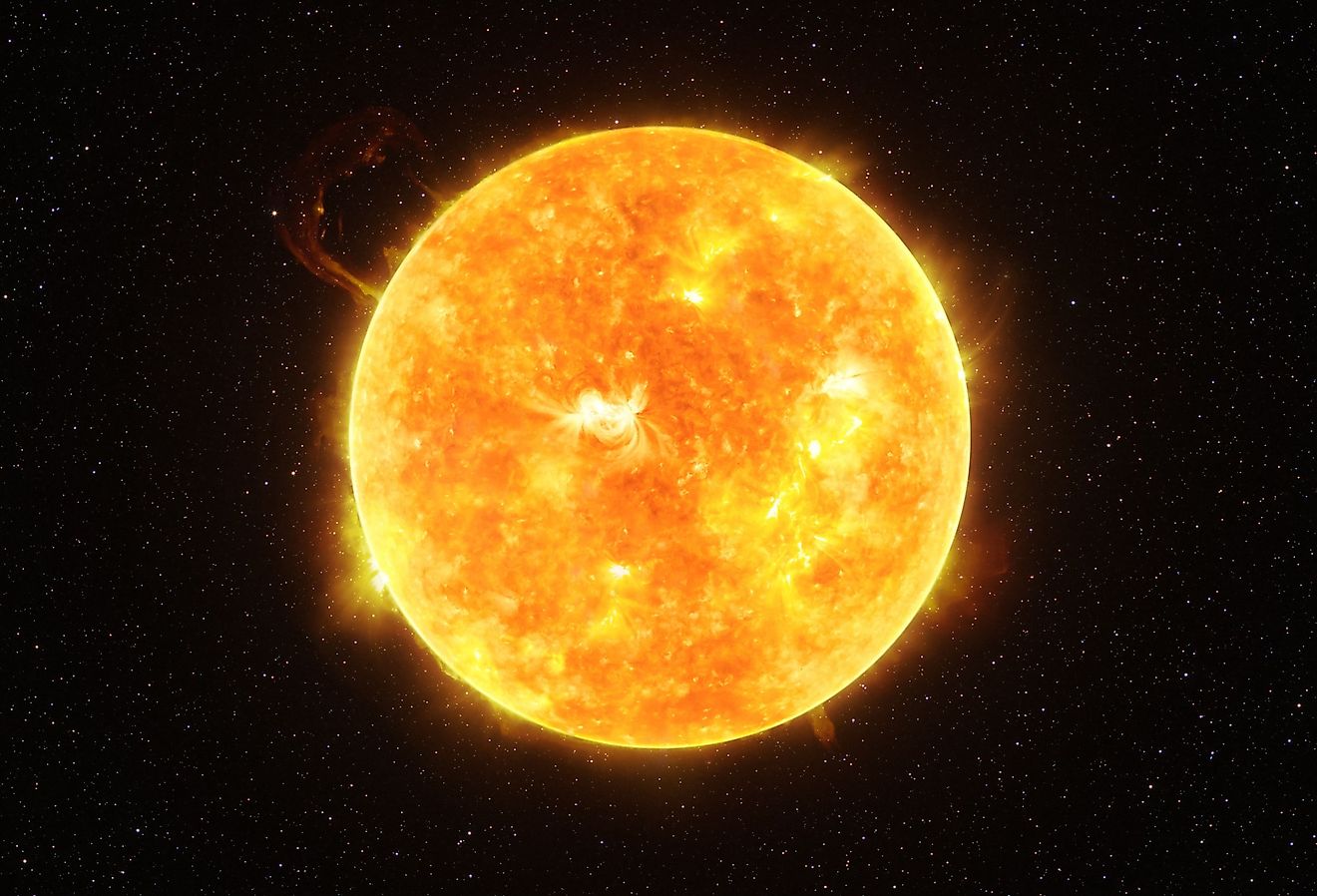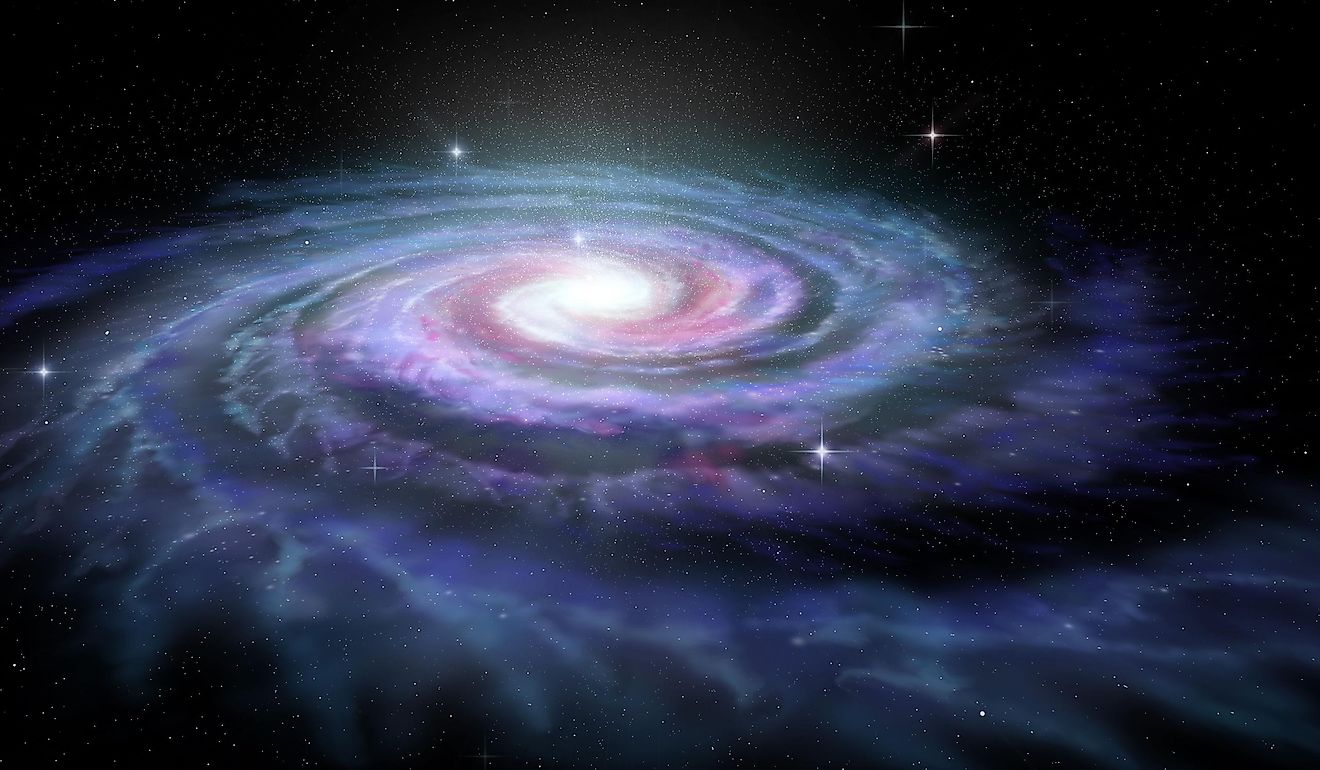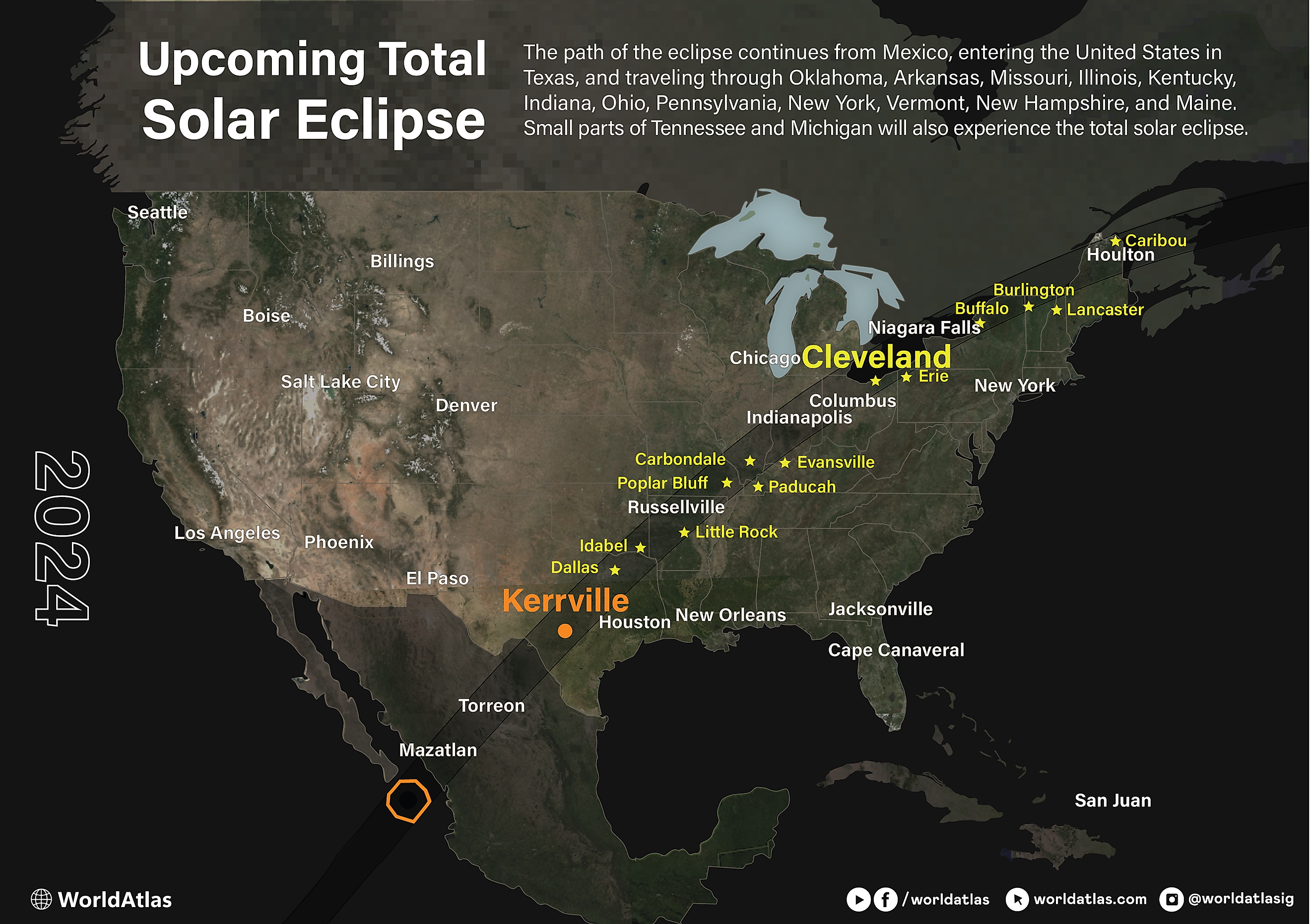
The Upcoming 2024 Total Eclipse
In less than one week, on April 8th, a total solar eclipse will occur over the United States and Canada after it crosses the Pacific Ocean and Mexico. Specific locations between Texas and Maine will get the chance to witness the event. To get a bead on 'where, what, and when,' WorldAtlas has you covered.
- The Two-Hour Eclipse's Location & Time
- The Four-Minute Peak Of The Eclipse
- What Is A Total Solar Eclipse?
- The Exact Path Of The Total Solar Eclipse Across The United States
- The Next Predicted Eclipse
The Two-Hour Eclipse's Location & Time
| Locations On Eclipse Path | Eclipse Begins | Eclipse Ends |
|---|---|---|
|
Dallas, Texas |
12:23 p.m. CDT
|
3:02 p.m. CDT
|
|
Idabel, Oklahoma
|
12:28 p.m. CDT
|
3:06 p.m. CDT
|
|
Little Rock, Arkansas
|
12:33 p.m. CDT
|
3:11 p.m. CDT
|
|
Poplar Bluff, Missouri
|
12:39 p.m. CDT
|
3:15 p.m. CDT
|
|
Paducah, Kentucky
|
12:42 p.m. CDT
|
3:18 p.m. CDT
|
|
Carbondale, Illinois
|
12:42 p.m. CDT
|
3:18 p.m. CDT
|
|
Evansville, Indiana
|
12:45 p.m. CDT
|
3:20 p.m. CDT
|
|
Cleveland, Ohio
|
1:59 p.m. EDT
|
4:29 p.m. EDT
|
|
Erie, Pennsylvania
|
2:02 p.m. EDT
|
4:30 p.m. EDT
|
|
Buffalo, New York
|
2:04 p.m. EDT
|
4:32 p.m. EDT
|
|
Burlington, Vermont
|
2:14 p.m. EDT
|
4:37 p.m. EDT
|
|
Lancaster, New Hampshire
|
2:16 p.m. EDT
|
4:38 p.m. EDT
|
|
Caribou, Maine
|
2:22 p.m. EDT
|
4:40 p.m. EDT
|
The Four-Minute Peak Of The Eclipse
It is crucial to remember that, in any affected locations, there is a building-up and a cooling-off for the visible event: although it may seem to last two and a half hours, the most important phase, the "totality," is less than four minutes long.
| Location | Totality Begins | Maximum | Totality Ends |
|---|---|---|---|
|
Dallas, Texas |
1:40 p.m. CDT
|
1:42 p.m. CDT
|
1:44 p.m. CDT
|
|
Idabel, Oklahoma
|
1:45 p.m. CDT
|
1:47 p.m. CDT
|
1:49 p.m. CDT
|
|
Little Rock, Arkansas
|
1:51 p.m. CDT
|
1:52 p.m. CDT
|
1:54 p.m. CDT
|
|
Poplar Bluff, Missouri
|
1:56 p.m. CDT
|
1:56 p.m. CDT
|
2:00 p.m. CDT
|
|
Paducah, Kentucky
|
2:00 p.m. CDT
|
2:01 p.m. CDT
|
2:02 p.m. CDT
|
|
Carbondale, Illinois
|
1:59 p.m. CDT
|
2:01 p.m. CDT
|
2:03 p.m. CDT
|
|
Evansville, Indiana
|
2:02 p.m. CDT
|
2:04 p.m. CDT
|
2:05 p.m. CDT
|
|
Cleveland, Ohio
|
3:13 p.m. EDT
|
3:15 p.m. EDT
|
3:17 p.m. EDT
|
|
Erie, Pennsylvania
|
3:16 p.m. EDT
|
3:18 p.m. EDT
|
3:20 p.m. EDT
|
|
Buffalo, New York
|
3:18 p.m. EDT
|
3:20 p.m. EDT
|
3:22 p.m. EDT
|
|
Burlington, Vermont
|
3:26 p.m. EDT
|
3:27 p.m. EDT
|
3:29 p.m. EDT
|
|
Lancaster, New Hampshire
|
3:27 p.m. EDT
|
3:29 p.m. EDT
|
3:30 p.m. EDT
|
|
Caribou, Maine
|
3:32 p.m. EDT
|
3:33 p.m. EDT
|
3:34 p.m. EDT
|
As the Moon slowly positions itself between the Earth and the Sun, the peak moment ("totality") may last as little as four minutes despite the Eclipse lasting around two and a half hours. For example, Dallas' Eclipse begins at 12:23 PM CDT and ends at 3:02 PM, but the most important segment is almost exactly in the middle of that timespan, from 1:40 PM to 1:44 PM; the peak strength of the Eclipse will occur at 1:42 PM.
What Is A Total Solar Eclipse?
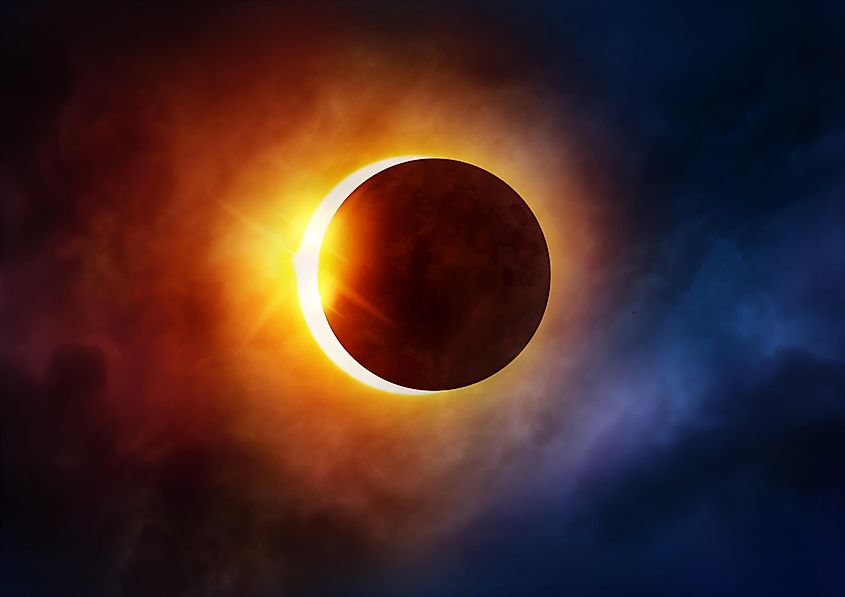
A total solar eclipse occurs when the Moon is directly between the Earth and the Sun. This creates a phenomenon visible to the human eye, wherein 'day becomes night.' Viewers who witnessed the 2017 eclipse in Oregon described it as "Sunset and Sunrise in every direction." If looking straight at the Moon, it will look like there is a pitch-black dot with a halo of white rays spilling around it, while the area around you is covered by shadow. In essence, the side of the Moon that people can see is entirely shadowed because the Sun is not facing it, but the Sun is strong and large enough for light to spill out around the edges.
The Path Of The 2024 Solar Eclipse
Relative to the USA, the Eclipse will begin in southwest Texas at noon and continue northeast through the midwest in a soft curve toward Ohio. Oklahoma, Arkansas, Missouri, Illinois, Kentucky, and Indiana are set to receive a moment under the Sun (so to speak), and even northwestern Tennessee has ten square miles involved. Then, after Ohio, the northwestern tip of Pennsylvania will fall under the Solar Eclipse's shadow, with the town of Erie at the center. Northern segments of New York and Vermont, as well as the tip of New Hampshire, will also be taking part in the solar eclipse around 2:00 PM EDT. Finally, north-central Maine will be bathed in the Eclipse between 2:22 PM and 4:40 PM before the Eclipse crosses into Canada (New Brunswick and Newfoundland) briefly and then dissipates over the Atlantic Ocean.
The Next Predicted Eclipse
On March 14th, 2025, a total Lunar Eclipse will occur. This means that, in the Pacific, the Americas, Europe, and Africa, viewers will watch the shadow of the Earth graze and cover the Moon because the Earth comes between the Sun and the Moon during lunar eclipses. Oddly, because sunlight has to pass through Earth's atmosphere, the Moon often reflects an orange-red hue during lunar eclipses.
Then, the next total Solar Eclipse will occur on August 12th, 2026, in Greenland, Iceland, Spain, Russia, and a little slice of Portugal. However, the next solar Eclipse visible from the contiguous United States will be in August of 2044, so witnessing the April 8th event is a once-in-a-lifetime opportunity for most.
Final Thoughts
YouTube videos and front-page photos of a total solar eclipse cannot compare with witnessing the event for oneself. Various cultures have regarded eclipses as cataclysmic religious events, yet the mysticism began to soften in the Second Century AD once predictions became reasonably accurate. Once, Christopher Columbus used a European prediction of a lunar eclipse in 1504 AD as a means to persuade and pressure indigenous tribes in Jamaica, who did not realize that such astrological events could be foreseen. Thankfully, today, a total eclipse is understood to be a beautiful example of nature's limitless ability to astound.
